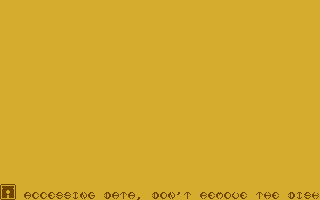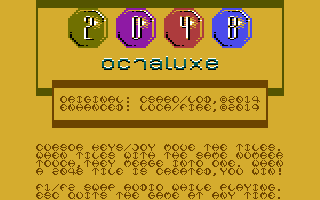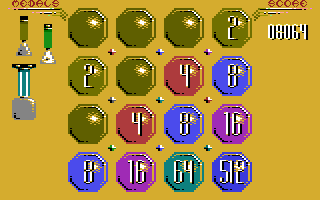|  2048 Octaluxe 2048 Octaluxe | |
| |
|  Image Gallery Image Gallery |  Hiscores loading  Titlescreen  Gameplay  Hiscores table
|
| |
|  Description Description | :: 2048 OCTALUXE ::
===================
2019 Luca/FIRE
A game's derivative version starting from Csabo's original 2048 source code. The core is basically the same, but massive addons have been included, although it still runs on a plain Commodore 16.
What reasons led to development?
2048 is a brilliant execution of the famous logical game, mostly due to the sober essentialism that pervades the whole code: the game has been converted minimizing any used resource, and that choice has taken to the classy octagonal tiles in order to use PETSCII elements only. The author had published the source code too, which appear to be a fine example of very neat module programming, with its libraries for the keyboard input and the text windows macros.
2048 merges tiles in a recursive mode per single move (see the related example picture which compares the two versions): a tile formed by the fusion of two tiles can merge with an additional matching tile in the same turn. Thinking it could be an aspect that could be improved, I proposed to the author a fixed version to prevent this behavior, thanks to the surprisingly readable source code, but he underlined that the described behavior represented the exact gameplay he wanted, and no fix would have been needed.
So, I decided to create a derivative version of the game, not only showing the correction of the gameplay, but a heavy rewriting of the code itself, driven by a philosophy opposite to that originally shown by the initial project: instead of spending as few resources as possible, the new version would have filled the memory of a Commodore 16 to its extreme limits. 2048 Octaluxe modifies some elements in the gameplay, adds music and sfx, allows scores saving, pushes in some ingame and intro graphics, and more. Many of the original macros in the code have been deleted in order to save any useful byte to make it fit under $4000.
Different gameplay
Of course, due to the previously described fixing, 2048 Octaluxe hiscores can't be put in the same board as its original game.
Medals
In order to pin some targets to reach (and to waste some memory for the graphics), a medal system has been added (see the Medals table). The player gains a new medal when a certain maximum tile or tiles' combo has been reached.
Diamonds
Nine little diamonds shine when the relative tiles merge together, in order to have a quick info about how good your last move has been. They're sequentially assigned: 4 8 16, 32 64 128, 256 512 1024.
Sound
2048 Octaluxe plays both music and sfx, the user can select to have music, sfx, none or both mixed.
This is the first time when a Knaecketraecker tune has been used in a game without any need of reloading it completely to prevent the initialize bug still present in the tracker's output. The credit for this mostly goes to Doug who debugged the player's code while extending the original player within his own projects, and after this I finished the complete debugging of it.
The low pitched sound at the beginning of the music has a lower frequency than the TED can generate, and was obtained with a trick on the pulse of the square wave.
Scores saving
The hiscores table the medal reached too, and can be saved at the end of any game. In the very beginning, once the program has been run, the code searches for the hiscores table file; if not found, or damaged, the hiscores table can be ignored or resetted. This allows the game to function even as a single file if wanted.
Animated directory
This is the first C16/Plus4 release to show an animated directory. Beware: the directory can damage your SD2IEC browser, so it's suggested to load it after no previously loaded browser.
|
| |
|  Commands Commands | | Joystick in any port |
|---|
| Keyboard |
|---|
| Up / Cursor Up | Move up | | Down / Cursor Down | Move down | | Left / Cursor left | Move left | | Right / Cursor right | Move right | | Fire / Space | Start game / Retry accessing hiscores table | | F1 | Switch music on/off | | F2 | Switch sfx on/off | | Escape | Quit game / Ignore accessing hiscores table | | S | Save hiscores / Reset hiscores table |
|
| |
|  Medals Medals |
|
| |
|  Animated Directory Animated Directory |
|
| |
Copyright © Plus/4 World Team, 2001-2025. Support Plus/4 World on Patreon |